Tom's Hardware CES 2018 Best In Show
CES 2018 Best In Show

The Tom’s Hardware team spent a busy week at CES, shuttling between hotel suite meetings and occasionally braving the Las Vegas Convention Center show floor to scope out the latest gear and emerging technology that appeals to PC and gaming enthusiasts. Despite rain and slick sidewalks, vehicular and human gridlock, and power outages, we prevailed! What follows is a list of superlatives--our picks for the best (and worst) from one of our industry’s largest tradeshows.
You can find all of our CES coverage from the week of the show (and beyond) here.
Most Refined VR Device: HTC Vive Pro

HTC introduced an upscale model of the Vive VR system during CES 2018, which sets a new bar for premium VR hardware. The new headset, dubbed the Vive Pro, isn’t a revolutionary change, but it does represent an important evolution of the VR industry. We saw several new VR devices at CES this year, but the Vive Pro demonstrated a level of refinement that we haven’t seen before in a VR headset. HTC didn’t just slap a new screen and a few features in a Vive and call it a day; the company put some real effort into improving the HMD in as many ways as it could.
The Vive Pro features an upgraded display that offers 78% more pixels than the original Vive (2880 x 1600 in the Pro compared to 2160 x 1200 in the Vive). The new headset also includes upgraded headphones with a built-in amplifier for better spatial audio reproduction, as well as dual chaperone cameras, so the passthrough video feed is no longer monocular. The Vive Pro also includes new Steam VR Tracking 2.0 sensors, which support up to four base stations for double the trackable volume.
Beyond the new features, HTC improved the ergonomics and the weight distribution of the headset. It also made several subtle changes, which result in a major overhaul. HTC redesigned how the data cable attaches to the headset so that it naturally routes to the side; it changed the relief adjustment from the dials where the strap attaches to the HMD to a button on the bottom of the HMD; and it updated the mechanical tension adjustment to make it more comfortable and secure.
These changes aren’t necessarily dramatic, but they are important, and taken together, they improve what was already one of the industry’s finest pieces of VR gear.
MORE: All CES 2018 Content
Stay on the Cutting Edge
Join the experts who read Tom's Hardware for the inside track on enthusiast PC tech news — and have for over 25 years. We'll send breaking news and in-depth reviews of CPUs, GPUs, AI, maker hardware and more straight to your inbox.
Most Innovative Laptop: Dell XPS 15 2-in-1
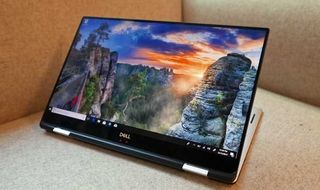
Sure, Dell’s redesign of its big-screen XPS machine involved turning it into a convertible, but all the advancements and innovations on the inside are really what make the XPS 15 a show-stealer.
The 8th Gen Intel Core Processor with Radeon RX Vega M Graphics (a.k.a. “Kaby Lake G”) chip should deliver some serious CPU and gaming grunt. Cooling is aided by Gore-Tex material (yes, the same stuff used in all kinds of outdoor clothing), with the aim of keeping heat from leaking into the chassis before the heat pipes can get it outside the chassis. Kaby Lake G processors consume 30% less space inside the chassis than a discrete graphics card, so Dell dedicated the extra space to a bulky cooling solution. Dell outfitted the internals with three fat copper heat pipes, two improved fans, and larger fins for heat dissipation. Those improvements should provide more performance during extended use.
And the keyboard uses magnets rather than rubber domes or mechanical switches to provide resistance. Although we’d have to dig in deeper before passing serious judgement, the brief time we spent with our fingers on the XPS 15 2-in-1’s keys left a positive impression. They remind us of the of the “butterfly” switches in Apple’s latest laptops, but travel feels less abrupt and jarring.
With all these features jammed into a 4.3-pound package, the XPS 15 2-in-1 is the new big-screen convertible to beat.
MORE: All CES 2018 Content
Best Power Supply: Corsair AX1600i
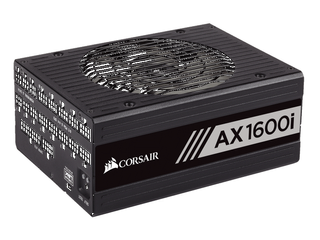
Corsair rocked the boat in the PSU market with the fresh AX1600i, which according to our evaluation results, is the best PSU that money can buy today. With 1600W of power, it can support a system equipped with multiple graphics cards, and its overall performance is extraordinary. At the moment, there is no PSU able to match the AX1600i’s efficiency levels, thanks to its totem-pole bridgeless PFC converter. This particular converter can be implemented only with Gallium Nitride (GaN) FETs and a digital controller, because at the moment, no commercial analog controller was available for the totem-pole PFC circuit.
Simply put, the AX1600i provides us with a glimpse into the future of PSU tech, where most PSUs will have digital controllers and GaN FETs, offering efficiency levels that exceed 94%. Corsair’s flagship PSU is expensive at $450, but such a high price is fully justified in our opinion because it packs so much technology into its internals, and it took years of experience and lots of resources from both companies enrolled into this project (Flextronics and Corsair) to make it happen.
Several PSU manufacturers are experimenting with this innovative PFC converter (totem-pole bridgeless), but Corsair managed to be ahead of the competition once again. (The first was with the AX1200i, with the AX1500i following a few years after.)
MORE: All CES 2018 Content
The Strangest Bedfellows Award: Intel 8th Generation Core With Radeon RX Vega M Graphics
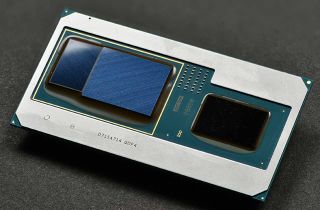
Business makes for strange bedfellows, as they say. Never has that been clearer than in Intel’s decision to use AMD’s Vega graphics on its latest processors. Intel’s 8th-Gen Core Processors with Radeon RX Vega M Graphics (yes, that’s the actual name), more affectionately known as “Kaby Lake-G,” brings the two rivals together onto one unified package.
The 65W and 100W processors come with four cores and eight threads complemented by two different AMD Radeon graphics configurations. The GH models come with 24 Vega Compute Units (CU), whereas the lower-end GL models come armed with 20 CU. Intel feeds the graphical beast with 4GB of HBM2 glued together with the company’s cutting-edge EMIB technology. Intel claimed the GPUs contend with Nvidia’s discrete GTX 1060 Max Q graphics.
The “enemy of my enemy” adage fits perfectly, as the unholy pairing is meant to chip away at Nvidia’s discrete graphics leadership. The result? Intel claimed it can cram these new processors into 17mm-thick laptops; Nvidia’s discrete GPUs limit you to a minimum of 27mm. Kaby Lake-G looks competitive on paper, and the overclocking knobs for the CPU, GPU, and HBM2 are neat if you’re willing to pay for them. We’re still trying to wrap our heads around what cooling an overclocked Kaby Lake-G will look in a tiny $999 NUC, but we’d be willing to try if you sent us one for free.
We aren’t sure if this project led to Raja Koduri’s leap from AMD to Intel, but it’s certainly possible. In either case, Intel now has a capable onboard graphics unit (for once) to tide everyone over until their new graphics architect whips up a suitable replacement.
MORE: All CES 2018 Content
Best Mouse: SteelSeries Rival 600
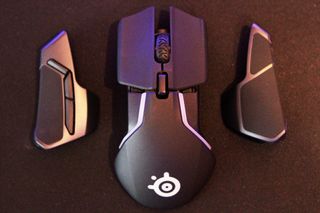
This year’s CES saw a number of wireless mice (with wireless charging) emerge, and that’s an intriguing trend to be sure, but the Steelseries Rival 600 stood out from this year’s pack of mechanical rodents. The mouse’s dual-sensor technology is designed to eliminate lift-off distance (LOD) drift, which ostensibly ensures better accuracy. SteelSeries also developed a removable weight system that lets you adjust not just the heft, but the balance.
These are fairly small details, but the fact that they’ve been addressed in the Rival 600 shows that SteelSeries is thinking hard about ways to improve the peripherals experience. This isn’t a one-off idea, either; it’s a continuation of the company’s work that began with the Rival and Sensei 310 mice.
MORE: All CES 2018 Content
Best System Cooling Innovation: Maingear APEX/F131

Maingear's Apex Integrated Cooling System is an impressive feat of engineering, with the new F131 custom desktop PC offering a truly unique open-loop liquid cooling setup you simply won't find anywhere else. (We certainly haven’t seen anything like it in recent memory.)
The company teamed with Bitspower to develop the clear acrylic reservoir/pump system alongside the new F131 chassis, making sure that it was a perfect fit for the updated flagship case (or rather, that the case was a perfect fit for the Apex). The dual-pump setup is set for quiet (low power) performance by default, but each individual pump is capable of running the entire loop (CPU, up to two GPUs, up to a 420mm radiator) if one ever goes bad. The Apex also sports built-in flow rate and temperature sensors with PWM cables to monitor its performance in real time, and it can be equipped with soft or hardline tubing.
Maingear has taken its love for customization to a new level with its Apex ICS open-loop custom liquid cooling, and it's the Best System Cooling Innovation we've seen here at CES 2018.
MORE: All CES 2018 Content
Coolest DRAM: Adata XPG JellyFish Project
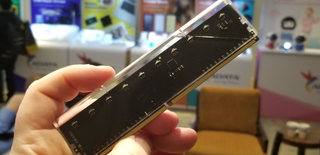
Project Jellyfish is Adata’s direct-to-die liquid cooling project for system memory. The patented technology was on display for the first time at CES 2018. Technical difficulties kept us from running performance testing on the proof of concept hardware but we expect to watch the technology grow into a product over time.
The liquid inside the sealed plastic shell doesn’t conduct electricity but does absorb heat from the components. The early version doesn’t have a way to cool the liquid yet; that’s a problem for the next revision.
Jellyfish was a nice alternative in the sea of RGB memory we saw at the show. Not to be out-dimmed in this area, the DDR4 system memory does have color lighting along the top that illuminates the shell and highlights the liquid.
MORE: All CES 2018 Content
Best-Value PC Case: Lian Li O11 Dynamic
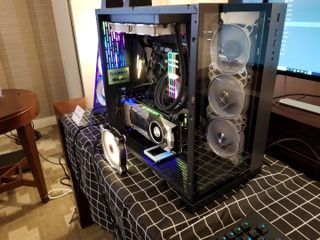
A Lian Li chassis for $129? Sign us up, we say.
Lian Li often resorted to a parallel brand (called “LanCool,” recently resurrected) to be the home for its lowest-cost cases, leaving the well-known, substantial aluminum builds and highly machined parts to the mother brand. The O11 Dynamic, designed in consultation with the well-known system builder and overclocker Roman “Der8auer” Hartung, is something of a departure from the Lian Li tradition--it’s a handsome hybrid of old and new.
The O11 Dynamic is an aluminum and tempered-glass effort that was designed with maximum space utilization in mind, while looking good doing it. This midtower chassis can support a pair of radiators, for starters. You can swap out a 2.5-inch drive or two via a small cage/caddy, which is accessible from the back panel. The sides fasten without screws, and you can remove the supplemental rear drive bay to install a second power supply. That’s a lot of flex for the money.
MORE: All CES 2018 Content
Best Standalone VR: Lenovo Mirage Solo Daydream HMD
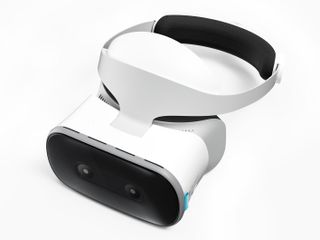
None of Lenovo’s many announcements this year impressed us as much as the Mirage Solo Standalone Daydream VR HMD. The Mirage Solo isn’t the only standalone VR device coming to market this year; Pico announced the Neo standalone HMD, and Oculus is preparing to launch the Oculus Go. But we think Lenovo’s device offers the most promise because of its superior specs and feature set, as well as its aggressive price point.
The Lenovo Mirage Solo packs a Qualcomm Snapdragon 835 VR SoC, which is Qualcomm’s latest and greatest mobile chip, and it’s optimized for mobile VR devices. The device also includes 4GB of memory, 64GB of storage, and a 5.5” QHD display, which is about as good as you can get these days in a mobile VR device. The Mirage Solo headset is also equipped with Google’s WorldSense 6 degrees of freedom (6DoF) inside-out spatial tracking.
As an added bonus, Lenovo has its Mirage VR camera that shoots in 3D at 180-degrees, which is perfect for this headset and the Daydream platform.
Ahead of CES, Pico announced that the Neo would sell for $750, which left us worried that it would set the tone for standalone HMD pricing. However, Lenovo will sell the Mirage Solo HMD for $400 when it comes to market in Q2 2018. A standalone HMD with room-scale tracking for the price of a Rift is a winning combination in our eyes, so we had to give Lenovo the Best Standalone HMD award.
MORE: All CES 2018 Content
Most Promising Consumer SSD: ADATA SX8200
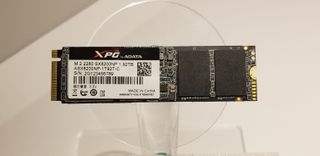
More cost-effective flash memory coming in the second half of the year kept the volume of new SSDs down at CES, but some companies moved forward with designs shown last June. The Adata XPG SX8200 is one such product that uses the latest Silicon Motion SM2262 controller and Micron’s second-generation flash to deliver premium SSD performance at aggressive price points.
The series scales from 240GB to 2TB in a simple-to-install M.2 form factor. The drives ride a PCIe 3.0 x4 bus and deliver up to 3,200 MB/s sequential read performance. Of the new SSDs on display that are close to a retail release, the SX8200 demonstrated the highest 4KB random read performance at queue depth 1. The Phison PS5012-E12-based products trailed by only a few IOPS, but will come to market a later than the XPG SX8200.
The SX8200 should hit your favorite retailer in the coming weeks. Products could begin shipping in as little as three weeks.
MORE: All CES 2018 Content
-
ddferrari Wow, this RGB/LED craze is really getting out of hand. Does my mouse pad need lights, too?Reply -
kinggremlin Reply20589208 said:Worst. CES. Ever.
Nvidia
No 2080 or 2070
I would have even liked a 2060.
What? Since when has NVidia announced new generations of video card at CES? 1080 was announced in May, 980 in September, 780 in May, 680 in March...
If one was to guess, look for Nvidia to have their typical special event to announce the 2080 in May. -
FD2Raptor Reply20589764 said:Wow, this RGB/LED craze is really getting out of hand. Does my mouse pad need lights, too?
Let me introduce you to the Corsair MM800 Polaris RGB Gaming Mouse Pad.
-
dalauder I like the Analog Gaming Keyboard. However, wouldn't it be sufficient to just do analog on WASD and arrow keys? At least, that's all I'd want on a cheaper variant. I guess you might want it on Space, L-Ctrl, or a couple others. I can definitely see a high end model that does it on all keys (you might want C, E, F, G & Shift frequently as well) and a lower end that only does WASD.Reply -
TechyInAZ Reply20589208 said:Worst. CES. Ever.
Nvidia
No 2080 or 2070
I would have even liked a 2060.
Nvidia doesn't do CES (for graphics cards). They will display new graphics cards around the 2H of 2018 as they always do. -
ddferrari Reply
:/ Thanks... I should have known.20590278 said:20589764 said:Wow, this RGB/LED craze is really getting out of hand. Does my mouse pad need lights, too?
Let me introduce you to the Corsair MM800 Polaris RGB Gaming Mouse Pad.
-
scolaner Reply20590636 said:I like the Analog Gaming Keyboard. However, wouldn't it be sufficient to just do analog on WASD and arrow keys? At least, that's all I'd want on a cheaper variant. I guess you might want it on Space, L-Ctrl, or a couple others. I can definitely see a high end model that does it on all keys (you might want C, E, F, G & Shift frequently as well) and a lower end that only does WASD.
Yeah, that's a good point. And that's more or less what CM did here with Aimpad's tech. But if you're doing a few, you may as well do them all... like Wooting: http://www.tomshardware.com/reviews/wooting-one-analog-mechanical-keyboard,5124.html
Most Popular






